This guide explains what local SEO is and how it can add to your business in Dubai. It helps you understand how local SEO works, what types of businesses are most suited for this strategy, and the most effective ways to do it when your business is located in Dubai.
Page Summary
What is local SEO?
Local SEO is an optimization practice that aims to enhance the prominence of a business in organic (unpaid) local search results. The optimization is focused on the Google Business Profile (GBP) and the business website to help search engines understand their fundamentals, including existence, location and credibility. It improves the appearance of both business entities in local search results, making it more likely to attract potential customers in this area.
Based on their appearance, Google serves two types of local search results: local map pack results and local organic results.
- Local Pack Results (Map Pack & Local Finder): Typically appear in the form of a listing at the top of the search results featuring 3 businesses and their location on a map. These listings include important business information such as: name, address, phone number, reviews, and links to the website or directions. They are generated based on proximity, relevance, and prominence and are particularly influenced by the business’s Google Business Profile.
- Local organic search results: Appear below the local pack results in the form of regular search results (“blue link results”). These feature individual websites relevant to the local search query, ranked based on the general SEO ranking factors such as: topical relevance, localized content (language, relevancy), local citations and user experience. Organic local results often include local directories, business websites, and blog posts relevant to the search term and location.
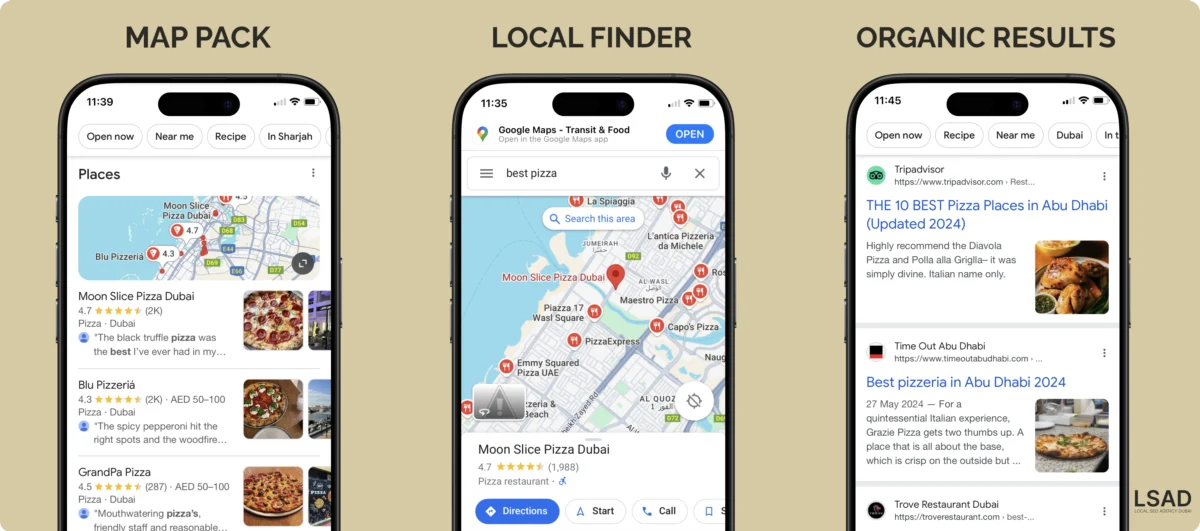
What is the difference between local and traditional SEO?
While traditional SEO has a broader focus aiming to increase a website’s global visibility and general search intent, local SEO aims to improve its visibility in a certain geographical area and for local search intent. In other words, both types of SEO aim to increase a website’s position in search results but vary in their strategic purposes based on the audience’s location and intent.
How does local SEO help to grow a business?

A recent survey in the U.S. shows that over 80% of customers who purchase a product previously inquire about it online through a local business. The same study also showed a great increase in the number of both local searches and local search results.
- A growing number of local searchers: an increasing number of users use local queries to find a business in their area. In fact, according to research by SOCi, 72% of users use Google to find a business near them, and 30% of them use location-related queries.
- A growing number of local search results: Recent research shows that Google prioritizes local search results over traditional organic search results.
That said, businesses that don’t have an optimized GBP are missing out on a lot of traffic and potential sales. According to this research by SOCi, businesses that appear in the local 3 pack receive 126% more traffic and 93% more conversions (calls, booking and direction requests) compared to businesses that rank below.
What types of businesses can profit from local SEO?
Both physical and online businesses can profit from local SEO in terms of the number of visitors, calls, and sales.
- Physical businesses that benefit the most from local SEO include all types of Brick-and-Mortar businesses (grocery stores, boutiques, restaurants, laundromats, law firms, etc) and service-based businesses (plumbers, locksmiths, arborists, handyman services). For example, restaurants often increase their number of customers through search results like “pizza restaurant near me” or “vegetarian restaurant in Dubai.”
- Online businesses, on the other hand, can benefit from local SEO through brand penetration and by improving their visibility in local search results (despite not having a physical storefront).
How to do local SEO in Dubai?
Local SEO requires coordinated and simultaneous optimization for both types of Google search results: the local pack and regular organic results (blue link rankings). Higher rankings in the local pack require parallel improvement in the organic search rankings. This is why a successful local SEO campaign requires a combined optimization of the business’s website and GBP simultaneously.
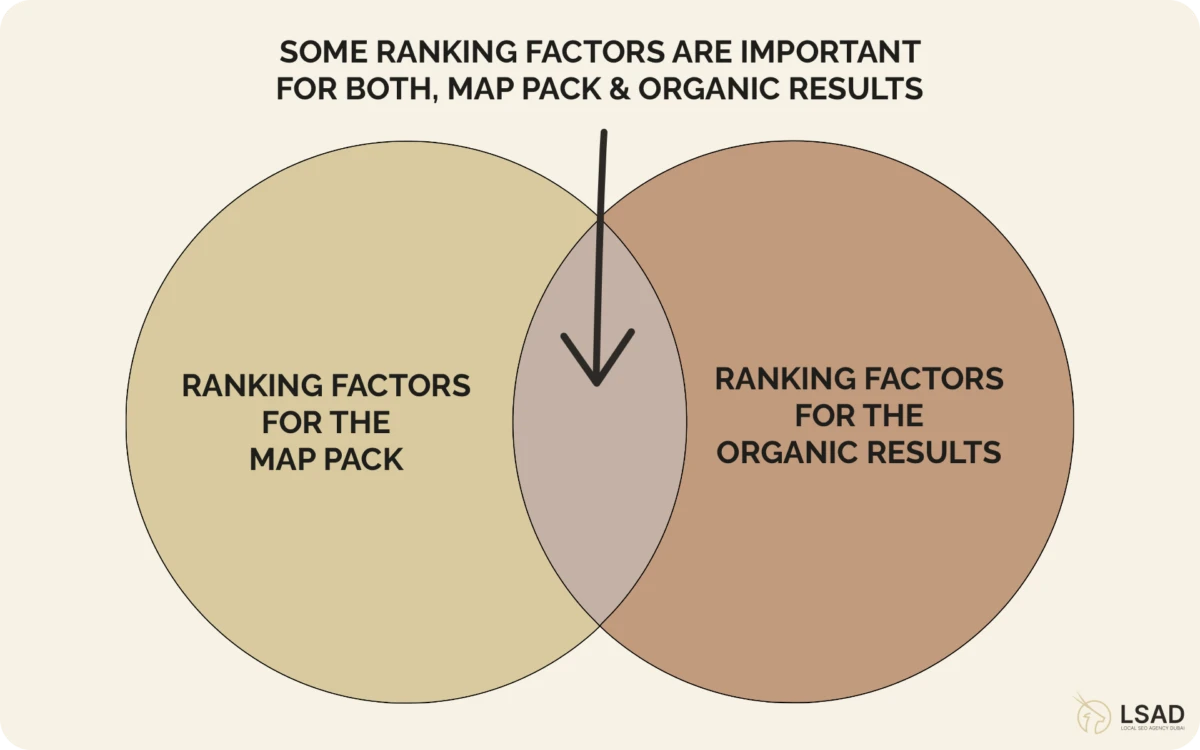
Our holistic approach to local SEO that includes optimization for both types of results is shared below.
Open, set up and claim your Google Business Profile (ex-Google My Business profile)
Google Business Profile (GBP) is a free online listing that shows essential information about a business, including its name, phone number, address, opening hours, services, reviews, website, and other information. Google provides the listing and allows businesses to determine their appearance in organic (blue link results) and local search results (map pack and Google Maps results)

Opening a Google Business Profile (previously Google My Business), setting it up (optimizing it) and claiming it (verifying it) are the first initial steps in the local SEO process.
How to open a Google Business Profile (GBP)?
To open a Google Business Profile, visit their official website (https://www.google.com/business/) and sign in using your business’ email address.
Account opening and set-up are straightforward and free of charge. It is important to use accurate business data, as information consistency is among the most important ranking factors.
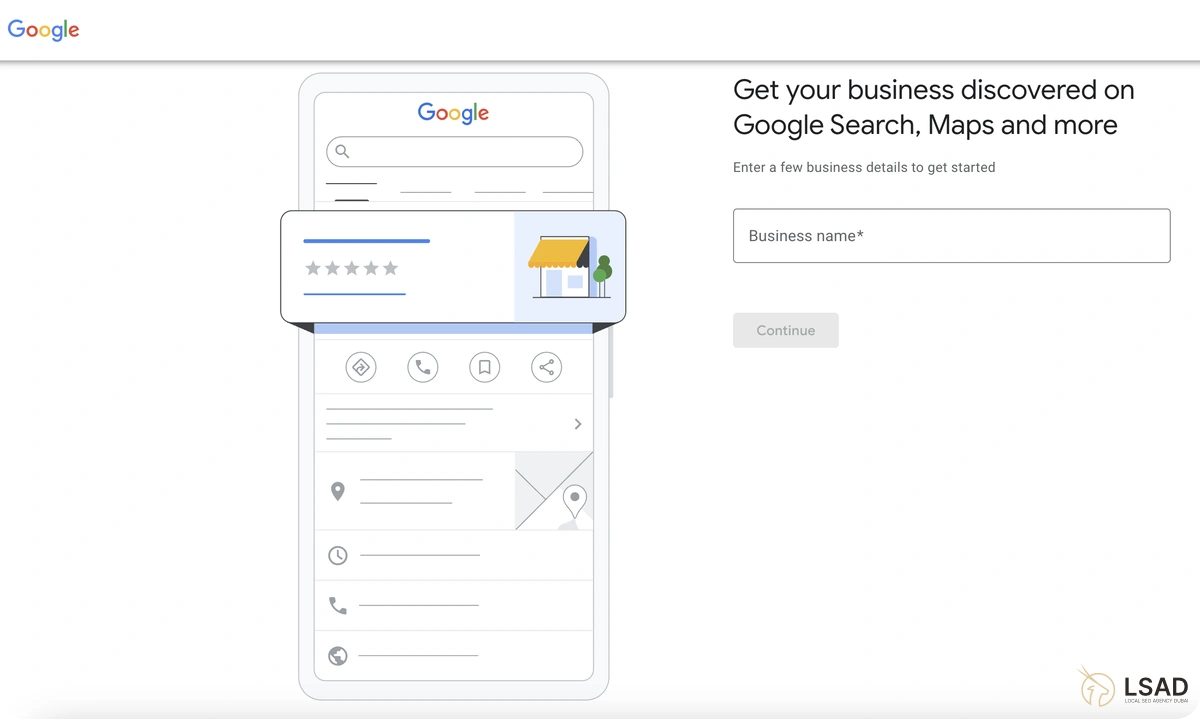
What are the best practices for setting up a Google Business Profile?
There are two different approaches to the Google Business Profile set-up: a professional approach that uses semantics to help Google easier understand a business (find out more about our GBP Setup service here), and a basic approach that follows regular settings, which allows for a good start in the less competitive niches.
The basic guidelines for a GBP set-up are listed below.
- Choose the right primary and secondary business category that best represents your core services
- Add the full name of your business, which is consistent across all of your entities
- Add semantically organized business descriptions covering main keywords and match them with descriptions on your website
- Add the accurate address if you have a physical location
- Set your business hours, including special closing hours on holidays
- Specify the most crowded times (popular times)
- Specify your service area if you deliver or visit clients
- Add your active social profiles
- List products, services and special offers
- Add high-quality (360) photos and videos to enhance your profile
- Encourage customers to leave reviews to build credibility
How to optimize your GBP in under 30min – Full Guide
How to verify and claim a Google Business Profile?
Google Business Profiles can be verified through multiple options, including phone, email, live call, video or postcard. Remember that some verification options are limited to certain types of businesses; for example, brick-and-mortar businesses must verify their business through a postcard.
Once the profile is verified, it normally takes 1-3 days to appear in Google Maps. It won’t be visible in the search results or maps until the GBP is verified.
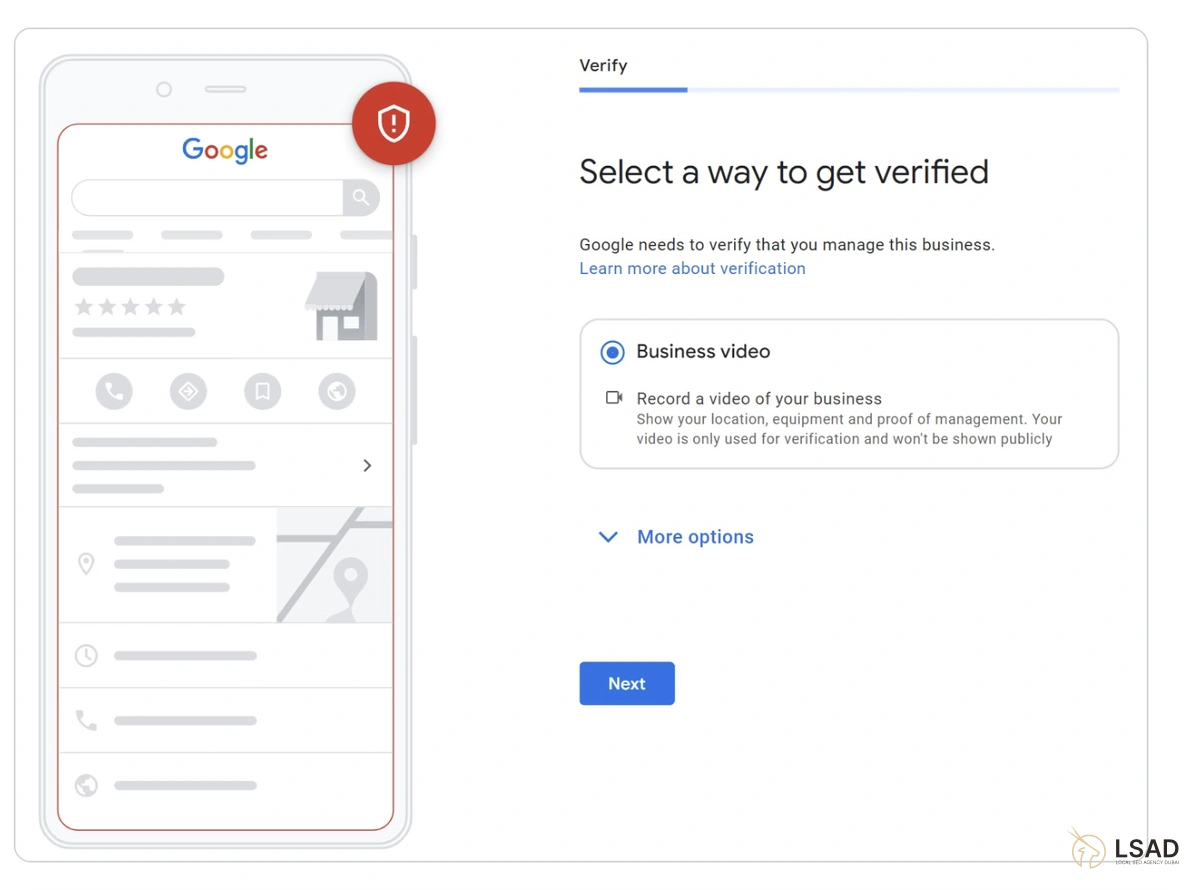
(Local) keyword research
Keyword research is the first and fundamental step of each local SEO campaign. It refers to defining the most valuable search phrases potential customers use to find a business. The keyword research process requires a good understanding of how people search for products or services, the keyword’s search volume and alignment with users’ search intent.
The 5 fundamental steps to keyword research are listed and explained below.
1. Seed list creation for service/product-based keywords
The first step of the keyword research process is to create a seed list of phrases that best describe a business’s product or service. This step requires defining relevant phrases people would use to find a business (its product or service), including general (main) phrases and phrases of secondary services that it offers,
Example: If your main service is car repair, you would want to rank not only for car repair but also for some particular services such as oil change, brake service, tyre service, and others.
A seed list for a business that offers car repair services would look like this:
- Car repair and maintenance (primary keyword)
- Car break repair and service
- Oil change and service
- Tyre change and repair
Various tools can help you create a keyword list, including Ahrefs, Semrush, and Google Autocomplete. These tools help you find relevant queries based on “seed” keywords (general services names) and show their search volumes. An example of how to use Ahrefs to create a seed list is shared below.
Example of local keyword research using Ahrefs:
To expand your seed list, insert your main keywords into Ahrefs and check if the suggestions match your services and users’ search intent.
For our example, we used “Car repair” as the main keyword and searched for it through the Ahrefs Keyword Explorer window. We have then selected: “Matching terms” to get a list of suggestions, including: car window repair, car AC repair and others, which we can add to our list.
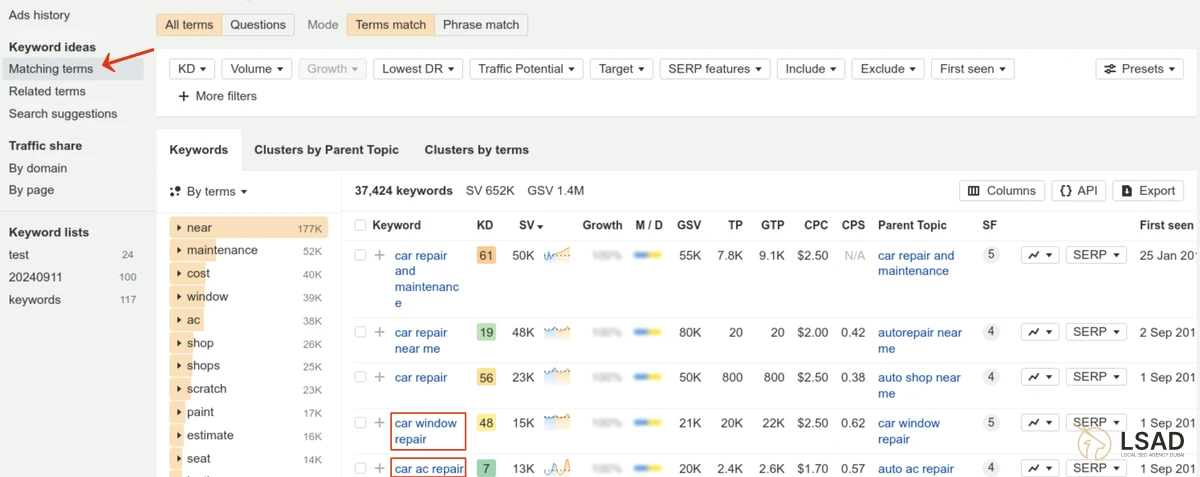
2. Analyze competitors keyword profile
The second step of the keyword research process is the analysis of the top 3 competitors. This method not only allows you to find new keyword ideas but also allows you to check which keywords are the most valuable for your competitors. The logic behind this approach is to check what works best for your competition and include it in your own strategy.
To find and analyze competitors’ main keywords, we suggest using tools like Ahrefs and Semrush. An example of how to leverage Ahrefs for competitor analysis is shared below.
Example of competitor analysis using Ahrefs:
Once logged in to Ahrefs, go to:
- Site Explorer
- Insert your competitor’s URL
- Select Top Pages on the left
- Look for URLs with service or product names

3. Filter keywords based on their search volumes
The next step in the research process is to compare search volumes of the keywords from your list to prioritize them in the optimization process.
The best way to check keyword search volumes for a certain geographical area (City, State) is to use Google Keyword Planner. The only real downside with this tool is that it only shows broad ranges of search volumes (1-10K).
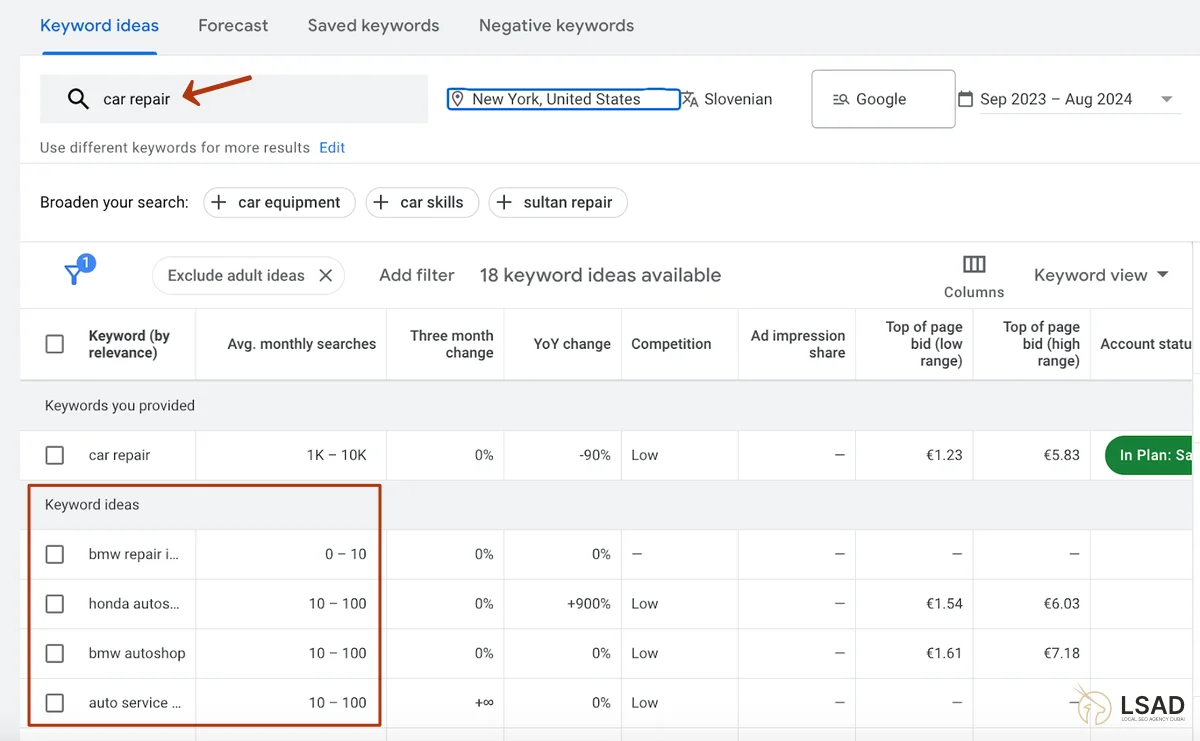
Other tools that can be used besides Google Keyword Planner are Ahrefs and Semrush. While these tools show exact search volumes for each keyword, they only reveal them on the national level rather than on city or country levels. Nevertheless, this is still the most accurate approach, as searches and volumes tend to be similar on city levels as on the national level.
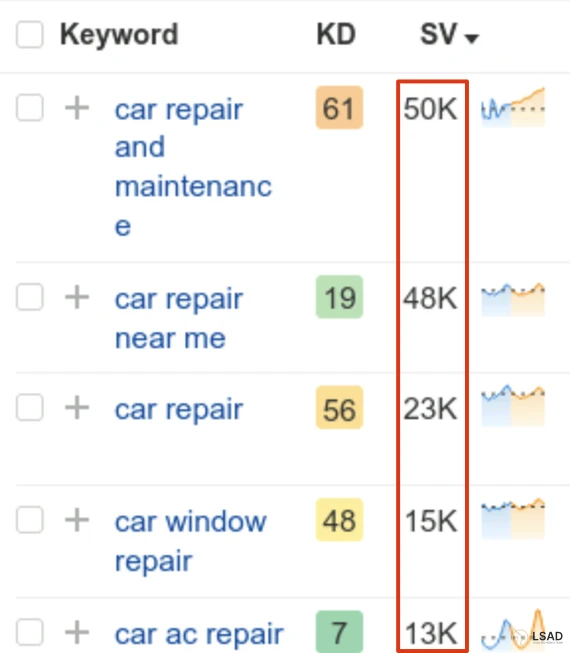
4. Check if Google serves local search results
The fourth step in the research process is to check if Google serves local search results for keywords on your list. Google search results appear in two variations: regular organic search results and local search results (local 3-pack at the top and local organic below them). They only show local search results if there is local search intent for a specific keyword (if users show the intent to shop near-by). If there are no local search results showing up, it means that there is no local SEO opportunity for that specific keyword.
To check if Google serves local search results for a certain keyword, simply Google it and check if local search results show up in the form of a 3-pack or Google Maps.

5. Determine primary and secondary keywords (which page to optimize for which keyword)
The last step in the process is to determine primary and secondary keywords. A regular rule of thumb is to optimize the homepage for the main (primary) keyword (broader search term like car repair), and inner pages for secondary keywords (more specific service areas like brake service, oil change). If you have a great number of secondary services, the probability that your homepage (which is the strongest and most relevant page on your website) will rank for all of the keywords is low. That’s why it is important to group secondary keywords and target them with separate inner pages.
Example: In our example, we would delegate the main keyword: Car repair Dubai to the homepage. We would also create separate inner pages for each of the other services (Oil change Dubai, Brake service Dubai) and rank each inner page for its own keyword.
To learn more about the process of grouping keywords and matching them with a specific URL, read our in-depth guide below.
How to do local keyword research?
On-Page SEO optimization
On-page SEO is the approach of refining your website’s content and HTML structure to make it more accessible to search engines and users. Helping search engines understand and find relevant information increases the chances of ranking higher in organic and local search results (local 3-pack and Google Maps).
Below is a checklist of the most important elements to consider for on-page optimization.
Technical On-Page
- Generate a website layout that is simple to understand and easy to navigate for users (UX)
- Use semantic HTML tags to describe an element
- Lower the rendering time and processing cost for web pages
- Use a hierarchic URL structure and include keywords in them
- Optimize images for lazy loading
- Make your website responsive for mobile and tablets
- Ensure the website is easily crawlable and cost-efficient for search engines.
- Include only essential URLs in the sitemap for indexing.
- Review and clean up internal links, ensuring they all lead to URLs with a 200 status code that can be indexed
- Avoid diluting ranking signals by covering the same topic on multiple pages
- Reduce website bloat by removing unnecessary announcements or news articles
- Prioritize HTML requests over resource requests
- Optimize URL parameters to prevent unneeded URLs from being added to the crawl queue
Content On-Page
- Optimize your website only for keywords that satisfy users’ search intent
- Use semantics for content creation
- Use internal linking to relevant pages
- Implement schema markup for NAP consistency
- Embed Google map to the footer, home page and About Us page
- Create a page with arrival instructions, sharing the best ways to get to your location (by bus, car, local transportation and walking)
What are the best tools for On-Page SEO?
Various tools can help you with either part of the on-page optimization process.
Tools for technical on-page SEO are listed below:
- Perfmatters WordPress performance plugin
- Google Lighthouse Chrome extension
- Imagekit.io image loading optimization plugin
Tools for on-page content SEO are listed below:
- Semrush on-page SEO checker
- Ahrefs keyword explorer
- Grammarly
- Surfer SEO
What should you consider when doing On-Page SEO for a multi-location business?
If your business has multiple locations, your on-page SEO strategy requires the creation of separate location pages for each location. This means each location has its own URL (page) dedicated to searchers from this area, where we share specific and more relevant information.
Example: When our car repair business has its headquarters in Dubai but also offers services in Abu Dhabi, Sharjah and Ayman, then you would dedicate the homepage of your website to the main location (Dubai) and create separate pages (URLs) for each additional location (www.carrepair.ae/abu-dhabi/, www.carrepair.ae/ayman/, etc.)
On-Page local SEO complete guide
Keep a constant activity on your Google Business Profile
Constant account activity and up-to-date information are among the main factors that Google’s search algorithm uses to determine the rankings of a specific website. The so-called “content freshness effect” is achieved through various ways that show search engines and users that profile information is up to date. These include:
- Updated business details (especially opening hours for holidays),
- Regular profile posts sharing the latest news about the business,
- Immediate responses to answers and user Q&As,
- Regular picture and video uploads
- Immediate review replays
What tools are best for activity automatization?
Various tools help you achieve account activity on autopilot, including Semrush Social, Localo app, Uberall and others.
Build and monitor relevant local citations
Local citations are mentions of a business’s fundamental information, such as name, address and phone number in local online outlets (directories, social profiles and websites). There are two types of citations depending on the number of listed information: NAP and NAPW.
- NAP include: name, address and phone number
- NAPW include: name, address, phone number and website
Search engines use these citations to verify the existence of a business, its location and credibility. In previous years, businesses that showed citation consistency tended to rank higher in Google as they were considered more trustworthy. Nowadays, citations are losing their spot among top-ranking factors as they are easy to replicate. Based on a survey by BrightLocals, 93% of SEOs believe search engines use citations to verify the existence of a business but are no longer among top ranking factors.
That said, the idea with citations remains to build as many as possible as proof of existence and credibility. Additionally, citations expose a business to local searchers (local directories tend to rank higher in search engines for local queries) and drive targeted traffic to the GBP.
How to build local citations?
There are various ways to find and create local citations. Our proven tactics are listed below.
- Competitor analysis – use tools like Ahrefs and Semrush to analyze and replicate citations of top competitors
- Get listed in relevant directories in Dubai (Yello.ae, AllDubai.ae, Localsearch.ae)
- Get listed in credible and relevant global directories (Foursquare, Localeze, Tripadvisor)
- Get listed on platforms other than Google (Facebook, TikTok, Apple Maps, Bing, Yandex, etc.)
- NAP and NAPW consistency
10 most effective local citation building strategies for 2025
How to find local citations using Ahrefs?
To find local citations using Ahrefs, follow the steps listed below.
- Step 1: Enter your website URL into Site Explorer
- Step 2: Click on: “Link Inspect”
- Step 3: Enter 3 of your top competitors
- Step 4: Switch the search mode to: “URL for all targets”
- Step 5: Click on: “Show link opportunities”
If your top competitor uses a directory or website, there is a high chance you can also add link to your business.
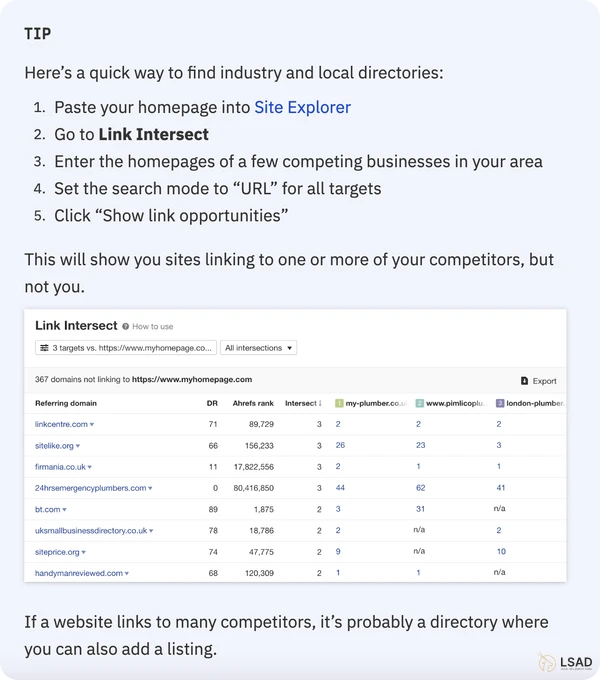
How to check and monitor local citations?
Local citations tend to be deleted or changed by the owner over time and, therefore, need to be constantly monitored. An effective and straightforward way to check existing citations for NAP consistency and also to find new publication opportunities is to use the Semrush listing management tool.
To get started, find and select your business from the search window.
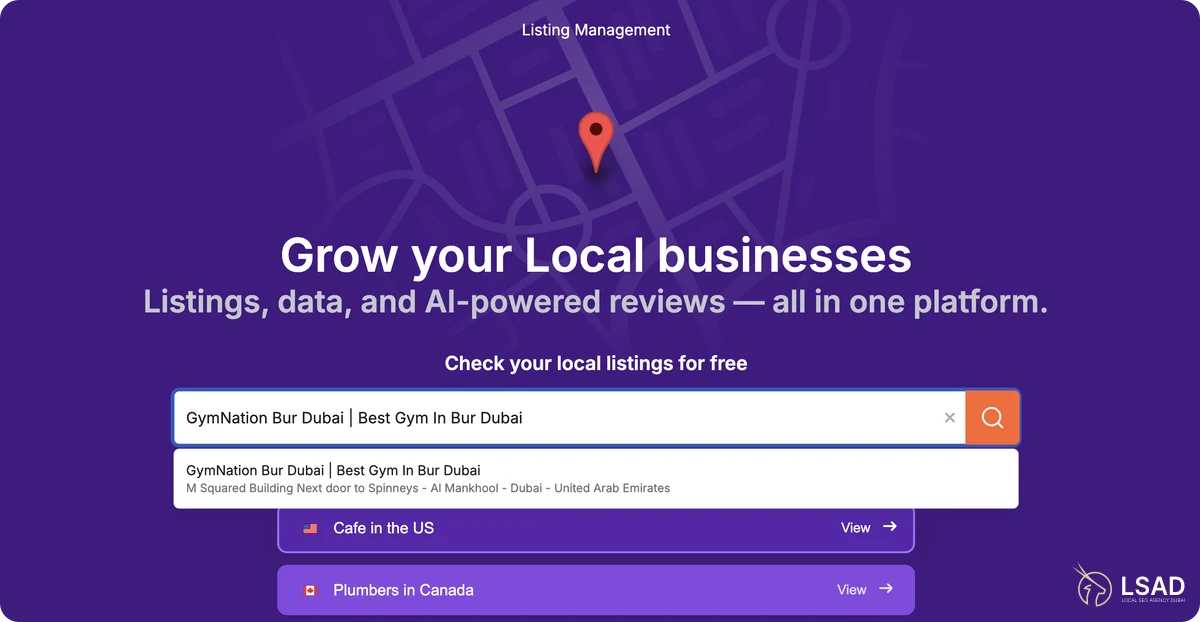
The free version allows you to get a detailed report on:
- The current listings that mention your business
- Listings with inconsistent NAP (listing with errors like a different name, number, etc.)
- Average rating (your citations expansion potential)
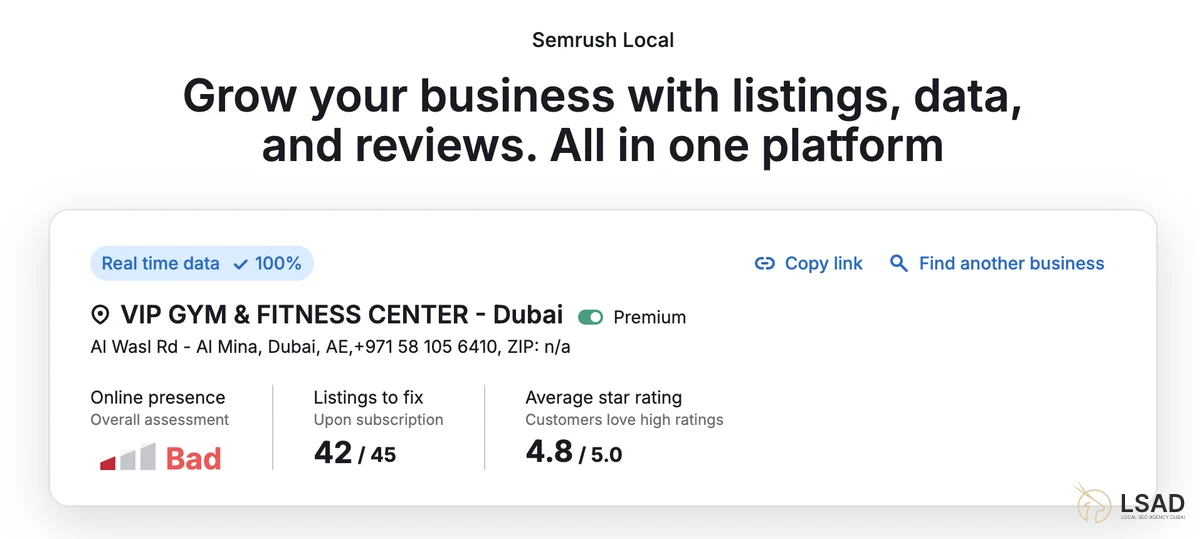
The paid version additionally allows you to distribute your business info to various local citations on autopilot.

Build backlinks to your website and Google Business Profile using digital PR
Backlinks are mentions of your website on other websites in the form of a clickable link. They work as votes for your website and are among the most important ranking factors in Google’s search algorithm. The more backlinks a website has from relevant and authoritative sources, the more quality it appears in Google’s eyes and the greater its chances to rank in the SERPs.
While a direct and proven correlation exists between backlinks and their impact on organic search results, their correlation with local search results (local map pack) has yet to be proven.
What are the most effective link building strategies for local SEO?
Below are some of the most effective link-building strategies for local SEO
- Reach out to your business partners and suppliers – if your business model includes business partners or suppliers who also have a website, it is a small ask for them to put your logo and link on their website.
- Contact local bloggers in your niche and provide them with quality content (case studies, research, field studies, etc.)
- Run a digital PR campaign – reach out to local newspapers and authoritative websites in your niche to write a story about your business. It has a high success rate of getting you great backlinks.
- Support local events as a sponsor – sponsoring local events is a good way of getting mentioned in local newspapers and the event’s main website.
Enhance customer reviews
Customer reviews are responses of customers regarding their experience with a business. Depending on where businesses are listed, customers can leave reviews on Google Business Profiles and other platforms like Facebook, Tripadvisors, Glassdoors, etc. While customer reviews listed on Google Business Profile are a direct ranking factor, reviews on other platforms are used as secondary trust signals to validate credibility.
Positive reviews are signals of customer satisfaction, trustworthiness and expertise of a business and build trust with potential buyers. But they are not only about comforting new customers. The number and average rating of reviews is also a signal of trustworthiness to Google and is an important ranking factor for the local map pack.
How to encourage more reviews?
There are a few tactics that can help businesses get more reviews, and some of our most effective tactics are listed below:
- Simplify review options for your customers by adding QR codes to your receptions, bills, business cards, and other materials that you use to engage with them.
- Ask satisfied customers gently to share their experience through a review. Happy clients are likelier to answer your request and leave a positive review.
- Create and share a discount code (for example, 10%) to compensate clients for leaving their honest reviews.
- Never buy reviews from online outlets, as this is against Google guidelines and can get your account suspended.
How to enhance reviews in 2025?
How to delete negative reviews?
Conclusion
To sum it up, local SEO is among the most effective strategies for growing a business in Dubai. It allows them to target relevant audiences with a high buying intention in a certain geographical location. Businesses not appearing in the local search results (local map pack) are missing out on 126% more monthly traffic and 93% higher conversions.
Article related FAQ’s
How much does local SEO cost?
There are 4 packages with different prices, depending on the various services they cover. The biggest package (Optimization package) costs $900/profile, the Management package costs $650/month, the Setup package costs $500/profile and the Support package costs $750/incident.
How long does it take to see results with local SEO?
It normally takes up to 6 months from the main changes to see results in organic local search, and it takes from 1-3 months to see results in the local 3-pack. The exact timeline depends on several factors, such as competition, algorithm updates, and the seriosity of website errors. Remember that smaller ranking boosts can be expected after a few weeks or months, while the full impact on traffic growth may take longer.
Can the agency provide case studies or references?
Yes, the Local SEO Agency Dubai (LSAD) has a special section dedicated to case studies showcasing their clients’ results.
Does the agency specialize in any specific industries?
Yes, the agency specializes in Google Business Profile optimization, which helps businesses improve their position in the local 3-pack and local organic search.
How does the agency measure success in local SEO?
The agency uses a few metrics to measure success with local SEO, depending on the nature of the service. These metrics include: Google Business Profile insights, Google Analytics, Google Search Console insights, and local conversion numbers such as clicks, calls, and sales.
